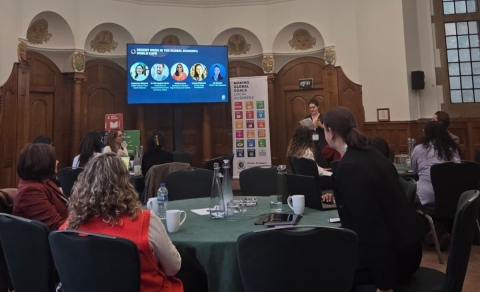United Nations Statement to the Development Committee: Joint Ministerial Committee of the Boards of Governors of the Bank and the Fund
12 APRIL, 2023
“We need to massively scale up affordable long-term financing by aligning all financing flows to the SDGs and improving the terms of lending of multilateral development banks. The high cost of debt and increasing risks of debt distress demand decisive action to make at least $500 billion dollars available annually to developing countries and convert short term lending into long term debt at lower interest rates.”
United Nations Secretary-General Mr. António Guterres
Development Setbacks: Breaking the Cycle of Crises
The global economy is facing multiple shocks that threaten to further reverse progress on the Sustainable Development Goals (SDGs). The COVID-19 pandemic socio-economic impacts, impacts from the war in Ukraine, high inflation, weak economic growth, tightening monetary and financial conditions, and unsustainable debt burdens – along with an escalating climate emergency – are wreaking havoc on economies across the globe. The effects of these cumulative shocks severely limit fiscal space in developing countries and are hurting their growth prospects. Impacts are aggravated by an unfair global financial system that is short-term oriented and crisis-prone, further exacerbating inequalities.
For the first time in 32 years, the Human Development Index, which measures a nation’s health, education and standards of living, endured a steep decline two years in a row. Human development has fallen back to 2016 levels, reversing much of the progress towards the SDGs adopted in 2015. This reversal is nearly universal, as over 90 percent of countries registered a decline in their HDI score in either 2020 or 2021 and more than 40 percent declined in both years. In comparison, in the aftermath of the 2008 financial crisis, the HDI kept improving.
The historic allocation of $650 in Special Drawing Rights by the International Monetary Fund, boosted liquidity at the height of the crisis. However, this allocation demonstrated the inequality built into the global financial system. Based on current quotas, developed countries received 26 times more than Least Developed Countries, and 13 times more than all the countries of Africa combined. Emergency financing should automatically go to the neediest countries. Under the current system, it is widening inequalities.
A “great finance divide”, as highlighted by the 2023 Financing for Sustainable Development Report, has sharply curtailed the ability of many developing countries to invest in recovery, climate action, and sustainable development.
The UN Secretary General’s SDG Stimulus Plan
The UN Secretary General’s SDG Stimulus Plan to Deliver Agenda 2030 (the SDG Stimulus)’ calls for a minimum of $500 bn in additional financing per year, aimed at mitigating the effects of cumulative shocks and providing developing economies with better access to long-term and affordable finance for sustainable development, including dealing with climate change. Implementing the SDG Stimulus will require urgent action from the G7 and G20 countries and the multilateral system at large.
More specifically, the SDG Stimulus puts forward three action areas for the international community: 1) tackle the high cost of debt and risks of debt distress; 2) massively scale up affordable long-term financing for development; and 3) expand contingency financing to countries in need.
Action area 1: Tackle the rising risks of debt distress and high cost of debt
Sovereign debt has reached critical levels, with more than a dozen countries in technical default or on the brink of default. Policy makers are in many countries are facing stark choices between paying creditors and fulfilling obligations to their citizens, postponing the long-term investments necessary for continued progress on sustainable development.
According to the IMF, about 15 percent of low-income countries are already in debt distress and another 45 percent face high debt vulnerabilities. And about a quarter of emerging economies are at high risk and facing “default-like” borrowing spread. For many countries key debt-burden indicators are back at, or approaching, levels last seen during the start of the last major international debt relief, the heavily indebted poor countries initiative.
The G20 Common Framework for Debt Treatments (CF) has been slow in addressing debt restructuring, foremost on the issue of creditor coordination amongst and between official and commercial creditors. Despite broad agreement on the shortcomings of the CF, the G20 has not yet found a consensus on the way forward and additional steps are needed to speed up debt resolution. The SDG Stimulus calls for both immediate and longer-term debt actions.
Immediately, the G20 should conduct an independent review of the Debt Service Suspension Initiative (DSSI) and the CF with the aim of putting in place an improved multilateral debt relief initiative to support debt payment suspensions, debt exchanges and/or haircuts, including a clear mechanism to include private creditors in official debt relief efforts. Among possible debt relief instruments considered should be debt for SDG and climate swaps and greater use of risk-sharing debt instruments such as state-contingency clauses. At the same time, the international community must work towards developing long-term comprehensive and structural solutions to sovereign debt challenges. In addition, debt sustainability analysis should distinguish better between liquidity and solvency risk and should also include scenarios of better access to long term affordable finance and SDG spending needs. At the same time, concrete steps must be taken toward a permanent mechanism to address sovereign debt distress as called for in the Addis Ababa Action Agenda.
Action area 2: Massively scale up affordable and long-term financing for development
In conjunction with improved debt management, the SDG Stimulus calls for a massive boost in investment on SDGs in developing countries, including financing climate action. Here, public development banks (PDBs), including multilateral development banks (MDBs), are uniquely positioned to play a more important role.
MDBs could, with stronger capital bases and better use of existing capital, increase lending from $100 billion per year to at least $500 billion per year. SDR (or in a broader sense reserves) rechanneling should feature as part of the discussion on MDB reform. Several promising proposals have been put forward on how to leverage SDRs (or other reserves) -- for instance by using them as MDB hybrid capital -- without compromising their reserve asset function.
MDB reform, including capital infusions, should aim at improving lending terms. First, by offering ultra long-term funding with significant grace periods to allow time for large scale SDG-related investments to yields results in terms of contributing to growth, wellbeing and productivity from human capital investments, and savings from investing in resilience to shocks. Second, by offering low interest rates which is especially important during periods of global financial tightening to act counter-cyclically. Third, by making use of state-contingent debt clauses that automatically provide fiscal breathing space when hit by exogenous shocks. Fourth, by providing a greater share of lending in local currency as this would contribute to lowering the borrower’s debt risk profile.
Similarly, there is also scope for many national development banks to increase lending. The SDG Stimulus also calls for strengthening the system of public development banks, including greater cooperation between MDBs, as well as between MDBs and PDBs.
Many developing economies will still need grants to support financing of the SDGs. Official development assistance (ODA) has failed to keep pace with rising needs and demands from the COVID-19 crisis and the impacts of the war in Ukraine. ODA remains at less than half the agreed target of 0.7 per cent of donor country gross national income. Meeting ODA commitments would provide over $150 billion per year in stimulus for the SDGs.
Finally, a new approach to blended finance is needed to draw in more private funding for sustainable investments. This includes a focus on development impact rather than bankability, use of non-concessional loans, and structures where the public sector can share both risks and rewards fairly.
Action area 3: Expand contingency financing to countries in need
The current international monetary and financial system exposes developing countries to sudden changes in financial market sentiment and high volatility of capital flows. The SDG Stimulus includes steps to strengthen the global financial safety net and address immediate liquidity needs to help countries improve their crisis response.
Developing countries have lost an estimated $379 billion of reserves in 2022, almost double of the amount of SDRs they received in the 2021 allocation. The SDG Stimulus calls for more ambitious international efforts in rechanneling SDRs at scale and ambition.
The international community should also continue to explore or accelerate the implementation of other mechanisms that can increase liquidity and boost available resources for sustainable development. Initiatives such as the IMF’s Resilience and Sustainability Trust, the Food Shock Window and the Loss and Damage Fund agreed to at COP27 are promising initiatives --keeping in mind that new instruments should be quick disbursing, with low interest rates, and parsimonious conditionality. Regional mechanisms can be explored to enhance liquidity and increase global access to Central Bank swap lines to help calm markets in periods of volatility.
Reform of the International Financial Architecture: WB Evolution and UN Partnership
The United Nations welcomes the World Bank’s Evolution Roadmap, Evolving the World Bank Group’s Mission, Operations, and Resources: A Roadmap. The Evolution Roadmap comes at a critical moment and represents a unique opportunity for the World Bank to step up its role in addressing the growing challenges to sustainable development.
The UN welcomes the World Bank efforts to address global challenges by expanding its mission beyond the “Twin Goals” (ending extreme poverty and boosting shared prosperity), emphasizing the importance of sustainability and resilience. The UN is extremely supportive of a World Bank that explicitly aligns its mandate with the 2030 Agenda for Sustainable Development.
By the same token, country-owned Integrated National Financing Frameworks (INFFs), which link country priorities and financing policies and needs, where available, can help guide strategies for the Bank’s operational engagement.
Realizing Our Common Agenda put forward by the UN-Secretary General, requires reforms within institutions as well as revamping the engagement between IFIs, the UN, and other stakeholders to better deliver sustainable development and Global Public Goods.
MDBs reform is critical in this endeavor as we need to massively scale up international public finance. MDBs shareholders have not increased the size of paid-in capital bases in line with the increase in size of the global economy or the needs for sustainable development investments, thus limiting their concessional and non-concessional financial capacity, including in middle income countries where needs become acute.
Multilateral players –including IFIs, MDBs, traditional and nontraditional donors, the G20 and the UN Development System —need to collectively step up with ambition to avoid “doing too little too late” against a debt crisis that has become cumulative. If collective action is not fast enough, a growing number of countries might reach the point of default with not just financial and economic consequences but also political instability.
In the run-up to the SDG Summit, the debate for advancing both international financial architecture reform and SDGs financing is gaining momentum in other forums, including the Bridgetown Initiative and the forthcoming Summit on a new “Global Financing Pact” organized by President Macron (Paris, June 2023). The discussion around the WBG evolution roadmap should be taken forward by the same token, as the world needs to recommit to the SDGs.
***
The UN stands ready to work closely with the World Bank in securing more rapid progress towards the achievement of the Addis Ababa Action Agenda, the SDGs and the Paris Agreement, and offers support in engagement with all stakeholders to achieve an ambitious outcome.












